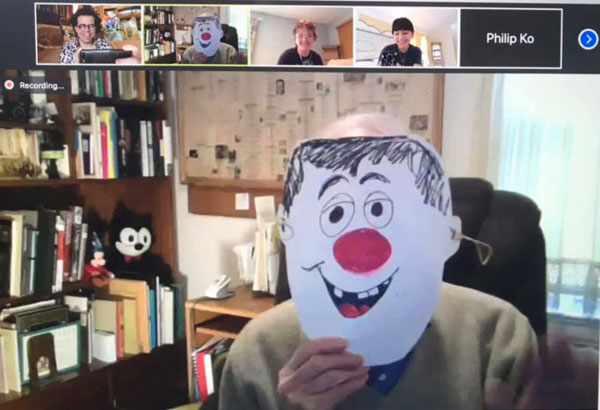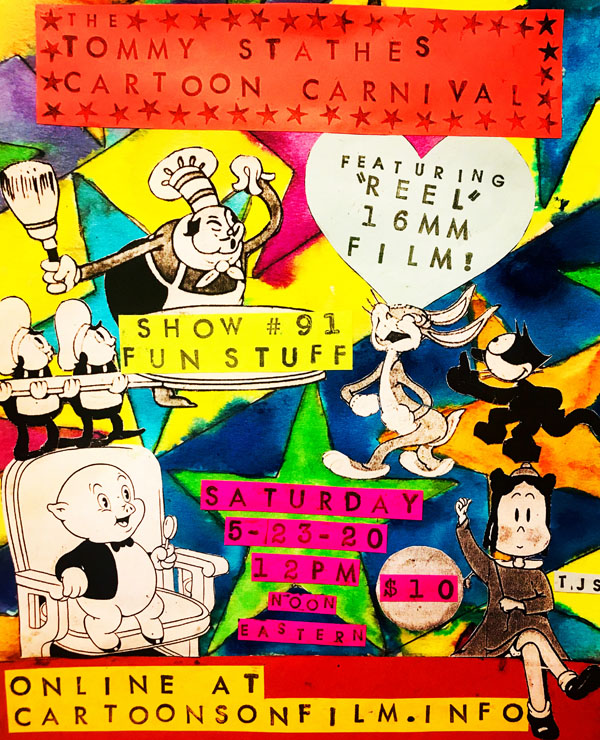While the world continues to erupt in largely avoidable chaos and morbidity, and our noble first responders do what they can to save the most precariously ill among us, it’s safe to say that many creatives on the sidelines are simply trying to stay afloat and keep doing things that will entertain others. All, hopefully, to benefit the greater good. As it has done since its inception, the animated film has been playing a part in providing comfort, enjoyment, and a bit of temporary escapism.

Howard Beckerman, as socially distant guest lecturer, appears in one of Tommy’s SVA classes via Zoom
I’ve asked my animation history and survey students at the School of Visual Arts and Feirstein Graduate School of Cinema to reflect on this concept of animation’s therapeutic abilities in their final papers for the semester, and many of them have confirmed my notion that the art form we love as a community has been something of a security blanket to them during these catastrophic times. As all of you Cartoon Researchers know, cartoons are not only for kids, and kids are not the only ones who need security blankets of sorts. Adults need comforting, and sometimes that comes in the form of an animated knee-slapper or tear jerker. And that’s perfectly okay.

Howard Beckerman, always a joy and comfort to speak with, realizes he forgot to put on a mask earlier!
The 16mm Cartoon Carnival has done rather nicely in its first two months of becoming a live streaming event, and based on some feedback I’ve been getting, it seems like the Carnival’s newfound availability to a global audience has been serving various entertainment and comforting purposes—especially for those who are not normally in the New York City area, and were mostly missing the brick-and-mortar events altogether! Everybody wins, or so it seems. That being said, it’s time to announce this month’s installment!

Program 91 in the series will take place this coming Saturday, May 23rd, at 12pm noon eastern time as a livestream. Gotta catch it in real time if you would like to watch! Considering our ongoing lockdown in New York City, I’m still limited to using films that had piled up here at home, without being accessioned and moved to storage before March, as well as new items that have been coming in on a regular basis. So, #91 is another potpourri of random fun, as was last month’s program. What I’ve been able to do is put together a selection that’s a pretty nice cross-section of early 1920s favorites of mine, such as Felix the Cat and Koko the Clown, as well as a few later Golden Age goodies thrown in for good measure…Porky Pig, Bugs Bunny, Little Lulu, and others. There will be a few other odds and ends to fill the bill, in our usual offbeat Cartoon Carnival manner. A black and white Terrytoon? Sure. Willie Whopper? You’ve got it!
It’s always such a pleasure and a privilege to share these films with audiences the way they were meant to be seen—via ‘reel’ film. I would be preaching to the choir here if I said that preserving early animation is valuable and important. What I will gladly reiterate, though, is just how much I believe in preserving the physicality of the archival prints and experiencing the films in this form, especially jointly, with friends and fans. Now, you can take part regardless of geographic location. Visit the new Online Cartoon Carnival page for more information and the ticket purchasing/stream viewing link here, and make sure you’re on our mailing list here if you would like to receive regular updates about these shows.

While our event posters sometimes give clues, I don’t normally advertise individual titles. Audiences always come in expecting a surprise—almost in the same way that kids in the 1930s and beyond would be treated to a random assortment of surprise cartoons at Cartoon Carnival events in their local movie houses, and especially in the way that folks throughout much of television history didn’t always know what cartoons they would be getting to see in a live hosted kiddie show from their local stations, or other syndicated packages of old cartoons that were run like clockwork over the decades. These historic experiences, where sitting back and relaxing without specific expectations was key, are something I also like to emulate a bit in this series. We come together for a bit of escapist fun, and not for nitpicking specific selections or ‘cine-whining’ about print quality or other anomalies.
In a rare exception, I would like to reveal one of this month’s selections and share an amusing anecdote about it, purely from a 16mm film archivist’s perspective, and without bloviating on the film’s merits (or lack thereof) in terms of production value or fan favoritism. It’s no secret that I’m a fan of the Van Beuren cartoons, and the Rainbow Parades (yes—even including Molly Moo Cow) happen to be favorites of mine. Alright, sometimes because of their obvious kitschiness and what we might now call a shabby chic aesthetic, at least compared with the more refined Silly Symphonies as far more critically acclaimed and commercially successful contemporary competitors. If I had a choice between Woolworth’s or Macy’s, I know as a fact that I would have more fun in a five and ten, and sometimes this holds true with my animated guilty favorites.

Fellow Cartoon Researcher Steve Stanchfield has made great strides in restoring the Rainbow Parade cartoons, and I know many of us are looking forward to their grand new rereleases. Luckily, many of these restorations have made use of master 35mm materials that simply weren’t known or weren’t readily accessible in prior decades, which means most of the films in that series will look far better than we’ve thought possible all along. Master materials hadn’t survived quite as well on the earlier Cinecolor entries in that series. For years, we could only watch somewhat soft and grainy 16mm prints of them from the 1940s, and even still, certain titles only circulated in black and white because those of us in the mix had not yet found color prints of all of them.
In 2013, Stanchfield wrote a Cartoon Research post about Pastrytown Wedding (1934), a Ted Eshbaugh-directed Rainbow Parade entry, sporting a lovely new 35mm print that had been rediscovered and was in the midst of being restored. This was one of those films that had only really circulated in black and white for many decades. The funny anecdote from behind the scenes is that just prior to this unearthing, the Pastrytown film was a momentary source of contention between us. When a worn old 1940s 16mm Cinecolor print finally turned up on eBay, and without expressly knowing each other’s interest in acquiring it, we unwittingly bid up the film by a few hundred dollars. Steve was the victor, and while we were both a bit saddened—him for having spent a lot of money, and I for not having the film—at least a color print was finally in good hands.


Nearly a decade later, I’ve finally been able to acquire my own 1940s Cinecolor 16mm print of the film. While it looks nothing like the 35mm version, happenings like this are a major cause for celebration here, as it’s otherwise a very elusive title in this form. I still really enjoy running a 16mm print more than a Blu-ray, as well (I didn’t say that, Cartoon Roots series!) My old Official Films black and white 16mm print has been suffering that fateful scent of vinegar for a few years now, and I’ll finally be able to feel better about having a *far* superior print as an upgrade. I look forward to sharing this one as part of Saturday’s live stream. Hope many of you will tune in, please check out our new trailer below – and please spread the word!


 Tommy Stathes is an animation historian specializing in silent era cartoons. He resides in New York and frequently holds public screenings throughout the city. You can read more about his work, his collection and his research on his website:
Tommy Stathes is an animation historian specializing in silent era cartoons. He resides in New York and frequently holds public screenings throughout the city. You can read more about his work, his collection and his research on his website: 
















































This is Off-Topic this post… But Tommy, any updates on your Felix The Cat blu-ray?
That’s interesting about the therapeutic potential of animation, and there may be something to that. But then I watch cartoons pretty much every single day, no matter what’s going on in my life, or in the world.
I watch old cartoons for therapy. The silent or non verbal ones are great, because if your near deaf, it matters not! These gems are made so well that verbiage is not needed to convey the message. Some of the old MGM cartoons like “To Spring” are so colorful that they are amazing.
One of my favorites is the first Flip the Frog, Fiddlesticks where a “Mickey Mouse” plays second fiddle (literally) to Flip!
Other favorites are Fleischer’s “Play Safe”, and the “Fresh Vegetable Mystery”. These cartoons are very original and no need for violence. There is action, no lack of action, but peaceful. This is why they are therapeutic.
That Commonwealth color cartoon box is an amazing sight!